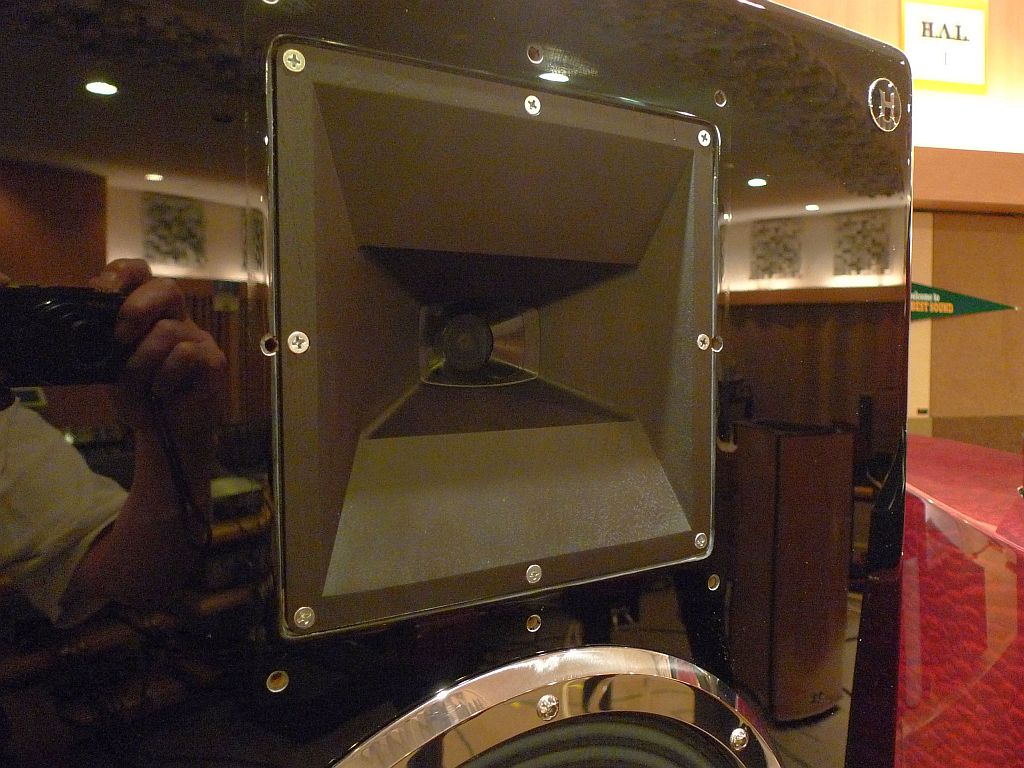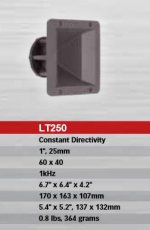"Ribbed for her(listening) pleasure"
For a 1,600Hz crossover, I would not select a 12" midrange with a ribbed cone.
I would select a smooth modern curve-linear cone shape, long fiber paper with carbon fibers and a heat-set plastic coating.
I suspect the ribbed cone 12" midrange is the reason the M1 must use a 40-degree horizontal and 60-degree vertical horn arrangement, instead of 60-degree horzontal.
Since the M1 is built in Switzerland, German and Italian vendors
Beyma has the 12P80NdV2 with a flat SPL over a wide bandwidth
BMS has the 12N820
18Sound has the 12ND930
Agreed I prefer the sound of smooth cones into the midband, the Beyma 12P80NdV2 looks excellent and a likely partner in my mind is the Beyma TPL-200/H but will consider CD units, Bass don't know atm.
Beyma 18P80nd could be the bass but its not ribbed
Beyma 12P80nd bass-mid
Beyma CP385nd CD
Beyma TD164 horn
pure speculation.
Daniel Hertz doesn't use off-shelf drivers. I used to think they use Beyma drivers but someday I woke up
I am yet to be convinced that 12"+TPL is the optimal combination.
Haven't used them myself but from other people's experiences TPLs are quite good crossed low but very, very good when crossed at 2k+.
Which makes sense when you look at the distortion curve Beyma publishes as it shows a 10dB dip at 2k. However this means that an 8 or 10" would be a better choice than 12.
Haven't used them myself but from other people's experiences TPLs are quite good crossed low but very, very good when crossed at 2k+.
Which makes sense when you look at the distortion curve Beyma publishes as it shows a 10dB dip at 2k. However this means that an 8 or 10" would be a better choice than 12.
pure speculation.
Daniel Hertz doesn't use off-shelf drivers. I used to think they use Beyma drivers but someday I woke up
You mean you woke up believing marketing speak?
Only joking but while looking for pictures of M1s I stumbled across DH M7 and M9s. One of those uses a woofer with a cone the colour of which I have only ever seen used by Beyma.
PMC also claim to use bespoke drivers but the 12" Volt they use is just the standard version but with a coated cone.
Not really what I would call 'bespoke' or 'custom-made' or which ever term they use especially since the standard version performs identically.
Getting them with coated cones is cheap on the one hand and on the other it means technically they cannot be accused of lying.
To be fair PMC do make their own 3" mid dome though.
I am yet to be convinced that 12"+TPL is the optimal combination.
Haven't used them myself but from other people's experiences TPLs are quite good crossed low but very, very good when crossed at 2k+.
Which makes sense when you look at the distortion curve Beyma publishes as it shows a 10dB dip at 2k. However this means that an 8 or 10" would be a better choice than 12.
The Beyma 12P80NvV2 is flat to 3K and - 10 dbs @ 4.5K
It's not about having a flat response, I kinda take it as a given that you wouldn't choose drivers which are all over the place.
It is about matching dispersion between mid and TPL.
Ideally you would want the dispersion to be the same at every frequency but that is not going to happen so the next best thing is to have the dispersion gradually narrowing from bass to treble and that is very much achievable.
A standard cone driver will beam at 90deg when the wavelength equals the drivers diameter. For a 12" that is 1200Hz, for 10" 1400Hz and for an 8" it is 1700.
Since the TPL does 80deg you can go a bit higher although I am not sure exactly how high but I strongly suspect that 2k is ok for an 8".
The audible effect of a speaker whose dispersion mushrooms out above a certain frequency (ie standard cone'n'domes) is that the timbre of instruments which cover that region changes if you move around the room due to uneven reflections.
It is about matching dispersion between mid and TPL.
Ideally you would want the dispersion to be the same at every frequency but that is not going to happen so the next best thing is to have the dispersion gradually narrowing from bass to treble and that is very much achievable.
A standard cone driver will beam at 90deg when the wavelength equals the drivers diameter. For a 12" that is 1200Hz, for 10" 1400Hz and for an 8" it is 1700.
Since the TPL does 80deg you can go a bit higher although I am not sure exactly how high but I strongly suspect that 2k is ok for an 8".
The audible effect of a speaker whose dispersion mushrooms out above a certain frequency (ie standard cone'n'domes) is that the timbre of instruments which cover that region changes if you move around the room due to uneven reflections.
The Beyma 12P80NvV2 is flat to 3K and - 10 dbs @ 4.5K
that's true when sitting on axis. a 12" will beam from about 1300-1400hz and from that point above the radiation pattern will get narrower gradually. according to one million rule a 12" cone at 3khz will be as narrow as ~27 degrees which is not good at all no matter how flat and linear and clean that driver is.
pure speculation.
Daniel Hertz doesn't use off-shelf drivers. I used to think they use Beyma drivers but someday I woke up
Maybe you`d like to share your findings with us, a kind of awakening for us all.
The horn used on the M1 looks like the 3.9” deep Aluminum LTC250 60x40 sold by several vendors including Eminence. This shallow depth was probably selected to create good CD time alignment to the 12" midbass. If you look close at the M1 you can see that the LTC250 horn is rotated so the narrower 40-degree beamwidth is horizontal. I suspect this was necessary to match the polar dispersion of the ribbed cone 12" midrange at 1600Hz. So, you can still get a smooth controlled directivity function if your 12" midrange produces smooth output beyond 1600Hz, but you may need to accept a 40-degree beamwidth beyond 1600Hz.that's true when sitting on axis. a 12" will beam from about 1300-1400hz and from that point above the radiation pattern will get narrower gradually.
=====
=====
A custom build of a 60H x 30V horn for the Beyma TPL-150 AMT tweeter could be one solution to a similar smooth controlled directivity function if your 12" midrange produces smooth output beyond 1600Hz, but you may need to accept a 60-degree beamwidth beyond 1600Hz instead of the 80H-degree of the standard aluminum Beyma horn. A good challenge for a 3D plastic printer!
The better curve-linear cone 12" midrange speakers have ~90 degree polar response at 1300Hz, as used on many SEOS12 EconoWave designs. The Beyma TPL-150 horn is 9" wide and 9" high. A custom build of a 12" wide 80H x 30V horn for the Beyma TPL-150 might make a 1300Hz crossover more acceptable. Another good challenge for a 3D plastic printer!
Many thanks for the info most helpful 🙂
I tried googling "LTC250" 60x40 Horn flares, but came up with nothing.
I tried googling "LTC250" 60x40 Horn flares, but came up with nothing.
If that's a 12" woofer, then that horn would be maybe 10" wide at most? If so, use Keele's formula for directivity control
f = K/(Theta * x)
(x is the width in inches for horizontal, Theta is coverage angle in degrees, f is lowest frequency where directivity is controlled, and K=1E6)
gives the lowest frequency that horn could hold to 40 degrees to be = 2.5kHz. Pretty durn high for crossing to a 12" woofer. Of course that assumes the M1 designer knows what he's doing. Astronomical pricing doesn't guarantee that (seems to trend the opposite way for a lot of silly-expensive stuff I've run into).
http://www.xlrtechs.com/dbkeele.com/PDF/Keele%20(1975-05%20AES%20Preprint)%20-%20Whats%20So%20Sacred%20Exp%20Horns.pdf
f = K/(Theta * x)
(x is the width in inches for horizontal, Theta is coverage angle in degrees, f is lowest frequency where directivity is controlled, and K=1E6)
gives the lowest frequency that horn could hold to 40 degrees to be = 2.5kHz. Pretty durn high for crossing to a 12" woofer. Of course that assumes the M1 designer knows what he's doing. Astronomical pricing doesn't guarantee that (seems to trend the opposite way for a lot of silly-expensive stuff I've run into).
http://www.xlrtechs.com/dbkeele.com/PDF/Keele%20(1975-05%20AES%20Preprint)%20-%20Whats%20So%20Sacred%20Exp%20Horns.pdf
The earlier (2010) Eminence catalogs have information on the LT250 horn. The depth spec varies from 3.9" for aluminum to 4.2" for ABS plastic.I tried googling "LTC250" 60x40 Horn flares, but came up with nothing.
...90H x 40V horns seem suited for HT family couch listening
...60H x 40V horns seem suited for a love seat
...40H x 60V horns seem suited for a throne 🙂
Attachments
...90H x 40V horns seem suited for HT family couch listening
...60H x 40V horns seem suited for a love seat
...40H x 60V horns seem suited for a throne
😀
a footage of M1 speaker. The cabinetry of this speaker IMO is no way in the $100K-ish league. just look at those self-tapping screws

For that money I would at least expect the screw heads to be lined up precisely but the man behind these is Mark Levinson who has a long track record of charging ridiculous prices.
Agreed, I would take it further a bit and demand for that kind of ridicilous amount of money that the screws are black anodized hexnut countersunk ones.
In some cultures screw head position is irrelevant. How does it affect the sound anyway?


Last edited:
In some cultures wealthy people appreciate that every aspect of a design is in accordance with the price tag. I would agree with that. The problem with "high-end" products is that the price does not guarantee its high-endness.
Agreed, I would take it further a bit and demand for that kind of ridicilous amount of money that the screws are black anodized hexnut countersunk ones.
Although I like black anodised hex screws as well one has to keep in mind that the screws that one can see here are covered with some bezel that has been removed for wahtever reason.
Regards
Charles
- Home
- Loudspeakers
- Multi-Way
- Daniel Hertz Levinson M1 wow
